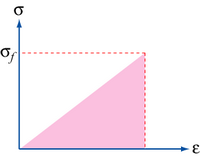11.8: Questions
- Page ID
- 36292
Quick questions
You should be able to answer these questions without too much difficulty after studying this TLP. If not, then you should go through it again!
Looking at the specific modulus - specific strength map for biomaterials, which material gives the greatest maximum elastic strain energy per unit mass?
- Answer
-
B
For which engineering application does the best steel perform better than the best aluminium alloy?
- Answer
-
C
Why is it favourable for viscid silk to have a high value of the merit index \( \frac{\sigma_f^2}{E} \)?
- Answer
-
B
Looking at the materials-selection chart toughness-Young's modulus for biomaterials, which of the listed biomaterials has the greatest fracture toughness, Kc?
- Answer
-
A. Antler. Wood also performs very well for this merit index.
Why would diamond not be used as a material that gives the minimum extension for loading a beam of given mass in tension?
- Answer
-
B. It is too expensive. It is also brittle and difficult to form.
Which of the listed commonly used engineering materials will show the minimum deflection on bending a beam of given mass with the cross-sectional area of the beam as the free parameter (i.e. which material has the maximum \(\frac{E^{1/2}}{\rho}\) value)?
- Answer
-
C. Alumina is however not used as it is brittle and expensive to produce compared to the other common engineering materials.
Deeper questions
The following questions require some thought and reaching the answer may require you to think beyond the contents of this TLP.
Derive the merit index for the maximum elastic strain energy per unit volume \( \sigma^2_f / E \).
Hint: Consider the stress-strain curve for an elastic, brittle material under tension.
- Answer
-
Consider stretching a perfectly elastic, brittle material. The stress-strain curve will look as follows:

The maximum elastic strain energy per unit volume is given by the area under the graph, therefore:
\[Energy = \frac{\sigma_f \varepsilon}{2} \]
As
\[\sigma_f = E \varepsilon\]
therefore
\[\varepsilon = \frac{\sigma_f}{E}\]
\[Energy = \frac{1}{2} \frac{\sigma_f^2}{E}\]
and the merit index for maximum elastic strain energy per unit volume is
\[\frac{\sigma_f^2}{E}\]
(...continued from previous question) Now derive the merit index for the maximum elastic strain energy per unit mass
\[\frac{\sigma_f^2}{E \rho}\]
Hint: Consider the relationship between mass and volume.
- Answer
-
The maximum elastic strain energy per unit volume is
\[\frac{1}{2} \frac{\sigma_f^2}{E}\]
and mass = volume × density.
Therefore the maximum elastic strain energy per unit mass is equal to the maximum elastic strain energy per unit volume divided by the density of the material:
Energy / unit mass = energy / (unit volume × density)
Energy per unit mass =
\[\frac{1}{2} \frac{\sigma_f^2}{E \rho}\]
The merit index for the maximum elastic strain energy per unit mass is
\[\frac{\sigma_f^2}{E \rho}\]


